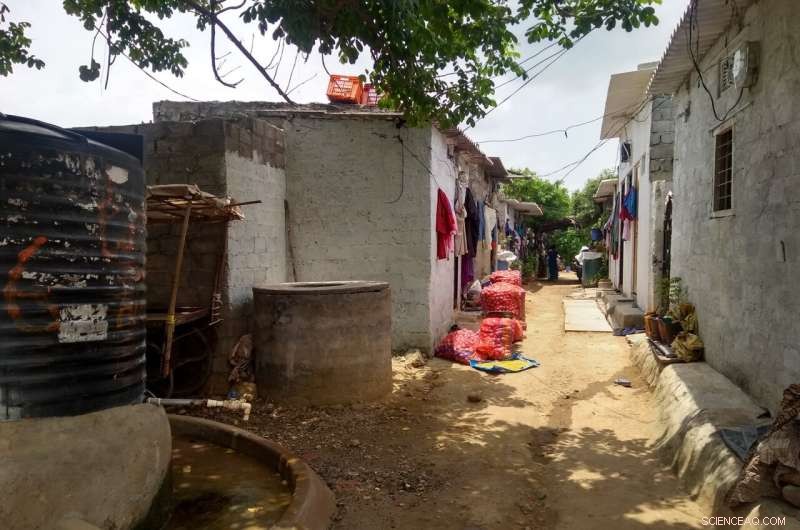
Esta foto está tomada en un área periurbana cerca de Hyderabad, India. En primer plano se puede ver la infraestructura disponible para el abastecimiento de agua. El área aún no se ha conectado al sistema de agua corriente, pero estos grandes depósitos de agua se pueden llenar con agua de lluvia o con agua entregada al área por camiones. En el medio del terreno, se pueden ver grandes bolsas de alimentos, que se pueden transportar al área utilizando vehículos, ganado y a mano. En el fondo, el espacio verde restante está presente, un marcado contraste con la vivienda relativamente densa en el término medio. Crédito:Profesor Simon Willcock
El mundo en el que vivimos a menudo se divide utilizando una distinción urbana-rural binaria, a pesar de un enorme gradiente de patrones de asentamiento en las ciudades y sus alrededores, que van desde las zonas urbanas hasta las zonas rurales más remotas. Nueva investigación liderada a través de un proyecto de investigación conjunto entre el Reino Unido y la India y publicada en Nature Sustainability , considera la urbanización al observar los cambios en la infraestructura natural, de ingeniería e institucional. El estudio, centrado en el Sur Global, sugiere que el cambio rápido en las áreas suburbanas (denominadas "periurbanas") da como resultado que las personas que viven en esas áreas tengan una calidad de vida más pobre que las personas que viven en áreas urbanas y rurales.
"La población urbana del mundo seguirá creciendo, lo que conducirá a un planeta cada vez más urbanizado, lo que a menudo resultará en una expansión urbana, a medida que las ciudades se extiendan e incorporen terrenos a su alrededor. Esta expansión de las ciudades es especialmente rápida en los países en desarrollo de Asia y África", dice el profesor Kenneth. Lynch (Universidad de Gloucestershire).
El profesor Simon Willcock de la Universidad de Bangor y Rothamsted Research dice:"A medida que las áreas urbanas se expanden, las características y los servicios disponibles dentro de las áreas cambian. Por ejemplo, la naturaleza y los productos naturales suelen estar disponibles de manera más inmediata en las áreas rurales, con niveles más bajos en las áreas urbanas, mientras que la infraestructura construida muestra el patrón opuesto. Esto a veces también va acompañado de un cambio del liderazgo tradicional local en las zonas rurales a un gobierno más central en las ciudades".
La investigación presenta una nueva teoría de la turbulencia periurbana, como explica el Dr. Paul Hutchings de la Universidad de Leeds:"La tasa de daños a la naturaleza y el costo de construir nueva infraestructura son factores importantes para determinar la calidad de vida de las personas que viven en zonas periurbanas". -áreas urbanas. Por ejemplo, cuando la extracción de productos de la naturaleza tiene un alto costo ambiental, entonces la naturaleza solo puede mantener a un pequeño número de personas. De manera similar, cuando el costo de construir infraestructura también es alto, entonces solo es económicamente viable apoyar a un mayor número de personas. comunidades. En una situación como esta, es probable que los recursos que provienen del mundo natural desaparezcan antes de que puedan ser reemplazados por infraestructura construida".
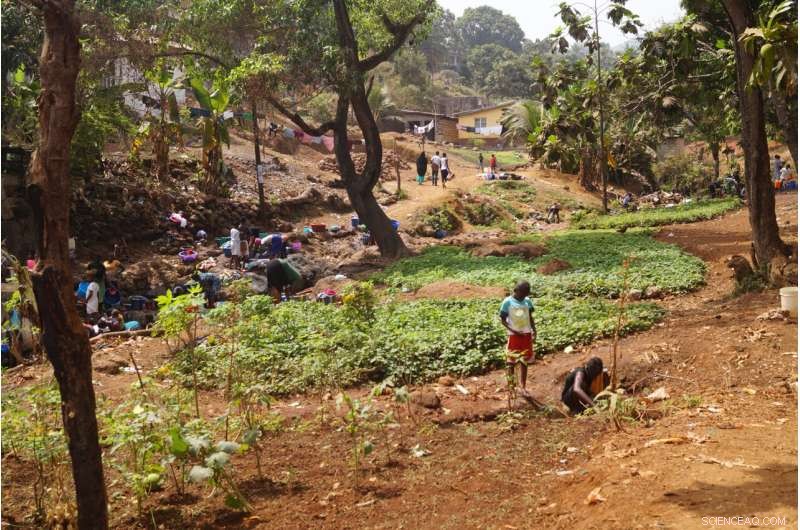
Esta foto está tomada entre dos vecindarios que miran hacia un arroyo cerca de Freetown, Sierra Leona. En primer plano se puede ver a dos niños sacando agua de un pozo para regar unas pequeñas huertas que tienen detrás. In the middle ground, a group of women and children are washing clothes and themselves in the stream and up the slope and behind the banana trees, the residential dwellings, some of which are in construction. You can also observe, rubbish littering the catchment, building materials in the form of boulders, some of which have been arranged to reduce erosion and landslip and dotted about some mature trees, some of which show evidence of having branches removed for fuelwood. Credit:Professor Kenneth Lynch
"Previous evidence supports this. For example, child health in East Africa is lowest in those communities living between the city and countryside, whilst a study in South Africa found that around two thirds of urban and rural citizens report that their quality of life had improved over the last five years, but only half of respondents reported such improvement in peri-urban zones," says Professor Kenneth Lynch.
Professor Simon Willcock explains the limitations of the theory:"This type of negative experience in peri-urban areas is greater for some services than others, and varies across geographic areas. For example, most food is grown in rural areas, but this can also be done within cities. Food can also be transported by road within cities with relative ease. However, there are likely to be big differences between groups living in each context. For example, higher income households and communities living in peri-urban areas have better access to the scarce resources. They can buy-in their own water, electricity, sanitation and so forth."
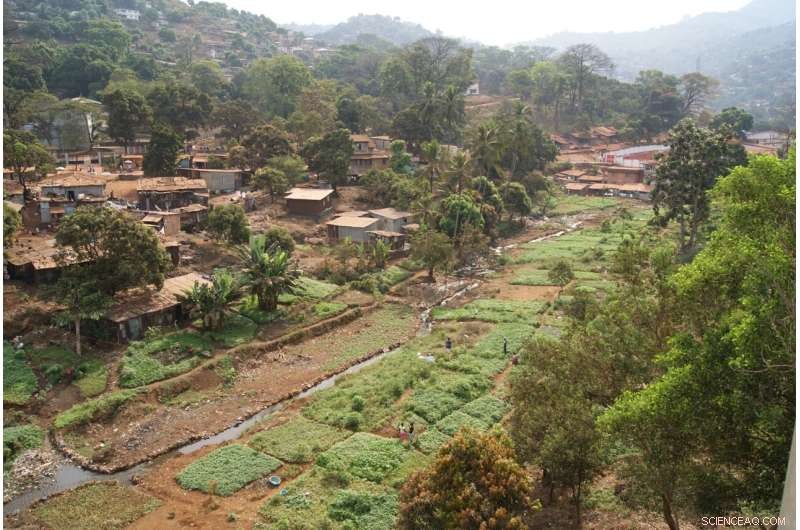
A site that floods during the rainy season that has thus far prevented development, allowing local people to use it for small-scale vegetable gardens near Freetown, Sierra Leone. Since this photo was taken two large developments have encroached on this site displacing the cultivators reducing the cultivated land cover and restricting the drainage channel, exacerbating flood water during the rainy season. Non-biodegradable waste (such as plastic bags and bottles) is used by cultivators to form drainage channels and protect plots from erosion. Credit:Professor Kenneth Lynch
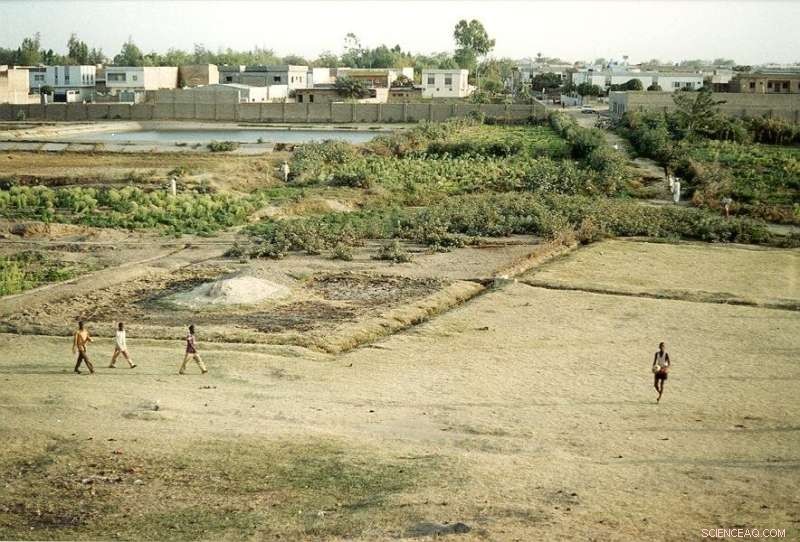
A seasonally flooded site within the old walls of the city of Kano, Northern Nigeria. You can see sites in the foreground are being used for small scale agriculture, but also plots have been marked out for construction and some sand and cement has been deposited ready for the installation of boundary markers. In the background you can see the high value residential areas that have a wall separating their neighborhood from the agricultural site. Many of the cultivators grow rice in the rainy seasons indicating this is for household consumption. During the dry season the cultivable land reduces to very close to the stream which is heavily polluted by nearby clothes dying works and the residential area. Encroachment on this site for residential development will exacerbate flooding further down the watershed. Credit:Professor Kenneth Lynch
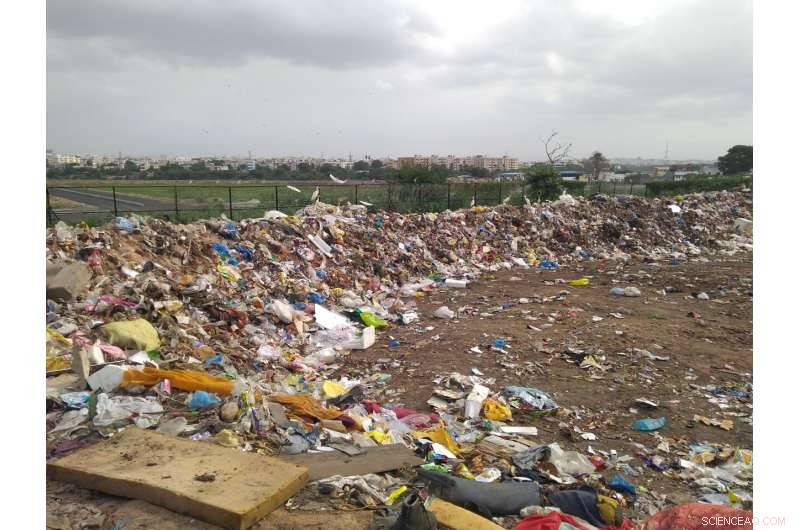
This photo is taken in a peri-urban area near Hyderabad, India. In the foreground, you can see a waste disposal area, receiving waste from the surrounding peri-urban areas, but also from the main city (shown in the background). This waste may present a hazard to the health of those living nearby, and risks polluting the nearby natural areas (shown in the middle ground). Credit:Professor Simon Willcock
Dr. Paul Hutchings concludes, "The bumpy road between natural and built infrastructure can be avoided. Some natural infrastructure can be conserved throughout urbanization through good city planning enforcing protection of green space. As well as this, services, such as municipal water utilities, can be subsidized so that they can be provided to people in peri-urban areas. Urban and rural planners, designers and architects should be working together to pre-empt the needs within newly expanded areas, and act quickly to prevent lower quality of life of the people living there." Study maps urban-rural catchment areas and points to ways to optimize policy and planning coordination for agriculture